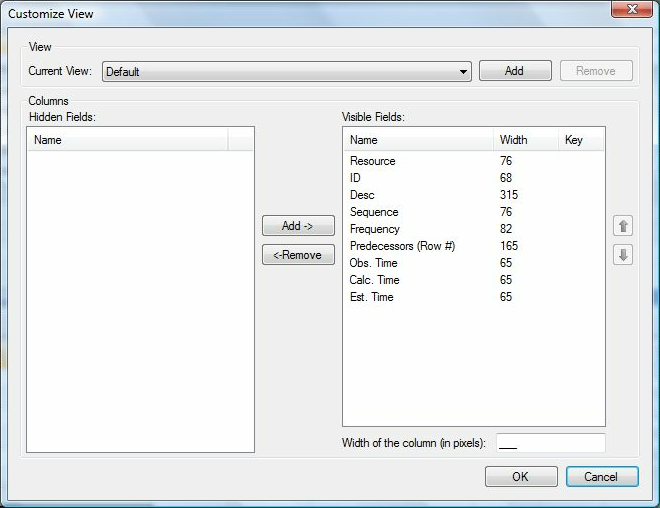The observed time tab contains two data tables: the Tasks table and the Observations table. You will notice a feature of all table columns is the ability to sort and filter row data. You can filter row data by clicking on the filter in any column header and selecting an entry to view all occurrences of that entry. You can also choose to sort and display rows in the table in ascending or descending order based on the column you are sorting. Do this by clicking on the up and down arrows in the column header.
See details of all columns and menu options below.
Options
In the Options section, you can define the operator performing each task, select the Study Type (Video or Stopwatch), and Reset the study data.

Options Section
Allowances
You can set a personal, basic fatigue, variable fatigue, and/or delay allowance for the study as a whole.
Allowance Section
Personal: Accounts for maintaining general well-being of the employee.
Basic Fatigue: Accounts for monotony or energy expended while performing tasks.
Variable Fatigue: Accounts for physical or mental strain or fatigue, caused by environmental conditions or nature of the work (temperature, posture, tediousness, etc.)
Delay: Accounts for interruptions, material irregularities, machine interference, etc.
Observations Table
Order: The order in which observations were recorded.
ID: The ID of the task. If no entry is made here, the row is given a default "New Task" ID.
Description: More detail about the task may be entered here, if desired.
Rating: The rating is a factor that allows the observer to adjust time based on the skill level of the operator performing the task.
The value entered in the rating column is divided by the Labor Rating, a default setting that may be changed in Tools > Options. Suppose the Labor Rating value is 100 (which is typical), and an average operator is observed. This operator would likely be given a rating of 100; there would be no net change in the time. If the worker is slower than average, assign him or her a rating less than 100. If they are significantly faster than average, assign him or her a rating higher than 100.
Start: The stopwatch time at which this element began.
End: The stopwatch time at which this element ended.
Ignore Time: If time was ignored during an observation of a task, the total ignored time for that task will be displayed.
OT: The observed time, which is the difference between the End time and the Start Time, excluding any ignored time.
NT: The normal time, which is the observed time multiplied by the operator rating.
Operator: Displays the operator that performed the observed task.
Vid File: Displays the video file from which the observation was made.
Comments: This field can be used to make any note related to the observation recorded.
Tasks Table
Task Index: A non-editable field that displays the order in which the tasks were organized at the time of the last save.
ID: The ID of the task. If no entry is made here, the row is given a default a "New Task" ID.
Description: More detail about the task may be entered here, if desired.
VA: Displays the value-added time of the task as defined by the double-click menu of the cell.
NVA: Displays the non value-added time of the task as defined by the double-click menu of the cell.
SVA: Displays the semi value-added (non value-added but necessary) time of the task as defined by the double-click menu of the cell.
Classification Total: Displays the sum of the VA, NVA, and SVA values defined for the task.
Standard Time: The standard time for a task is calculated as the average of all normal time observations for that task, multiplied by any allowances that are defined for the study or the task.
Task Image: Displays the most recent snapshot taken of the task. Double click on the cell to see a larger image.
Allowance: You can specify an individual allowance for each task using an allowance code. The allowance associated with that code is displayed in this cell.
Allowance Code: There is a set of allowance codes loaded; if you wish, you can select an allowance code to be applied to a task. The corresponding allowance value will be populated in the Allowance cell.
Confidence Interval: The confidence interval set for each task helps determine the required number of observations. You can reset the default confidence interval in Tools>Options.
Required Observations: This column displays the number of observations required to achieve the confidence interval set for each task. See Required Observations Calculation for more details.
Right Click Menu
Cut: Copies and cuts the information from the selected cell or row.
Copy: Copies the selected cell or row.
Paste: Pastes the copied data.
Insert Rows: Adds blank rows above the selected row, the number of rows dependent on the number of rows requested in the window that pops up.
Remove Selected Rows: Removes the selected rows and the data they may contain.
Clear Selected Data: Deletes the selected cell(s) or row(s).
Customize View: A window will appear like the one below. Columns in the selected table can be hidden, shown, or rearranged to meet each user's needs.

Customized View
View Video (Observations table only): A window will appear that allows you to view the video clip of the selected observation.
Compare Two Videos (Observations table only): A window will appear that allows you to view video clips of any two task observations for analysis and improvement purposes. Please see Compare Two Videos for more details.